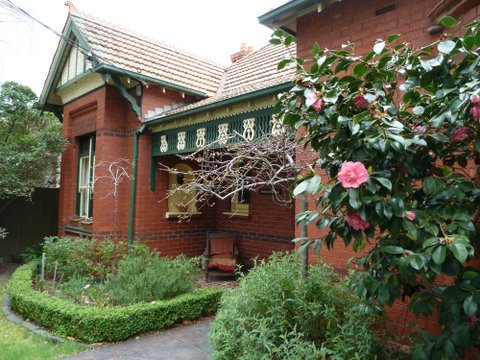The history of the street where we live here in Melbourne dates back to around 1890, which is when the land was subdivided and the first houses were built, in the Victorian style of that period. There was a lull in building due to the 1890s depression however, and the Melbourne Golf Club was able to take advantage of the financial crash to purchase two single level Victorian villas for use as clubhouses and to establish an extensive golf course in the surrounding area. The land on which our home was subsequently built was part of the golf course until the Melbourne club and its successor the Caulfield Golf Club moved further afield in 1907. The photographs below are held at the Stonnington History Centre web site: http://www.stonnington.vic.gov.au/explore-stonnington/history/stonnington-history-centre/ . They show the gentlemen club members lounging on the verandah of their club house, with the lady golfers in a similar pose at their separate club house across the road, although the ladies do look a little more formally dressed than their male counterparts!
 |
MP 183 Associates
at Royal Melbourne Golf Club at Caulfield [East Malvern], about 1892
|
Our house was originally named Wirreandah, which is an Aboriginal word meaning 'place of big trees where rock wallabies hide'. It was built in 1910, some twenty years later than its next door neighbour. In this first decade of the early twentieth century, the Edwardian or federation style of architecture was in fashion. Timber fretwork replaced iron lace decoration, but internal architectural features such as decorative plaster cornices, elaborate ceiling roses, and picture rails were still popular, together with colourful stained glass windows at the front depicting flowers, animals or birds. I've included an estate agent's advertising photograph here rather than one of my own, because it shows the stained glass windows well.
 |
| An inviting shot of our modest villa, taken by Real Estate Agent Marshall White, 2008 |
| You may recognize this photo from my blog header |
The first owner of the property was a Mr Thomas Gill, agent, who purchased it together with two neighbouring lots in June 1908. By 1910 three houses were built on these lots and a Mr Arthur Jennings Price, solicitor, had become the occupier, while Mr Gill remained the owner. This Arthur Price had been married previously, but his first wife had committed suicide by cutting her throat at home in her bed in 1896 in another part of Melbourne. It appears from the inquest that she had confessed to an affair for which Arthur had told her he could not forgive her, and he had left the home a few days earlier. Her body was discovered by her small son, who must have only been about three years old at the time. Very sad! I must say I'm rather relieved that this tragedy didn't happen in Turner St. Arthur and his second wife Constance Faerie Clarke were married in 1908 and had one daughter, Constance Thura Price, who was born here in 1910/11. Arthur Price died in 1922, aged 55, and his widow advertised for someone to share the house with her, perhaps for financial reasons. She purchased the property in 1923, but when she remarried in 1925 she appears to have let it out to a Mr and Mrs Leslie Gray, to whom she eventually sold the house in 1941. The Grays sold in 1964 to a gentleman who resided next door (on the opposite side to the former club house), and it was held in his family until we bought it five years ago, so it has been, as they say, 'tightly held'.
| Hobnobbing with the gentry? |
There are several impressive and well-preserved two storey Victorian homes in the next street in particular, and I've included photographs of two of them here. It's likely that they would have been built around the same time as the gold course was established, and perhaps some of those ladies and gentlemen of the Melbourne Golf Club resided in these rather grand residences.
And where to shop locally? Just at the end of the street a solid block of shops was constructed and subsequently extended, as shown in these two further pictures from the Stonnington History Centre collection.
 |
| MP5036 Shops in Waverley Rd, c 1900 |
 |
| MP12068 Waverley Rd, c 1922 |
This commercial building complete with its lookout tower still survives today, and is occupied by several business people, although some of the premises are currently empty and it's no longer the thriving hub of activity that it looks to have been in its heyday.



1 comment:
You have a beautiful home Jo.
I'm with you - I'd be glad that the first Mrs Price didn't die in my house. So sad that her little boy found her body.
Post a Comment